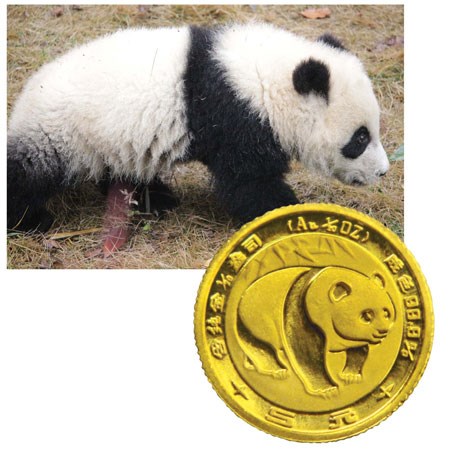Chinese Pandas: They're So Cute!
Posted on 7/14/2015
By
Peter Anthony
As I stood and watched three Panda cubs play and tussle and vie with one another to climb a tree, the young woman next to me squealed over and over again, "They're so cute! They're so cute!" I think that sums up the basic appeal of both the Panda animals and the coins; they're so cute!
When it comes to Panda coins there are none cuter than the little 1/20 oz. gold Pandas. Many people even refer to them as baby Pandas. Like real Pandas, the 1/20 oz. coins had an interesting birth story.
When Panda coins were first released by the China Mint in 1982 there were four sizes: one, half, quarter and tenth ounce. There wasn't any plan to strike a coin smaller than 1/10 oz. Other mints, though, like the South African Mint and the Mexican Mint, did produce 1/20 oz. gold coins. The companies that distributed and sold the Panda coins felt that they needed a smaller Panda to compete, especially with Mexico's two peso coin.
In early 1983 there was a meeting in Japan between the distributors and the China Mint. Louis Vizgor of Manfra, Tordella and Brookes, a New York-based Panda distributor, proposed the idea of the smaller Panda. The China Mint accepted this idea. Some months later the first 1983 1/20 oz. 5 Yuan gold Pandas appeared.
They hit the market during a wave of popularity for China and Pandas. The 1984 Summer Olympics were held in Los Angeles. The Soviet Union and most of its Eastern European allies boycotted these games. The People's Republic of China, however, sent its first-ever Olympic team to the games. This move was a gold medal winner with the American public. For the Olympics, China also lent a pair of Pandas to the Los Angeles Zoo. Hundreds of thousands of visitors to Los Angeles went to see them. No doubt many exclaimed, "They're so cute!"
The mintage of 1983 5 Yuan Pandas is about 75,000. With this many struck you might expect it to be a common coin, but it isn't. For one thing, few people collected and saved the tiny Panda. Collectors favored the 1/10 size with its larger, easier to see design. Moreover a date set of 5 Yuan coins would always be short one coin compared to the other denominations. So not many 1983 5 Yuan Pandas were saved in mint state by collectors.
The new "baby" Pandas were in demand, though. They found a home in the jewelry industry. Within a few years as many as 10,000 1/20 oz. coins per month were used in rings, bracelets, earrings and more by a television cable channel.
Because collector demand was not high for 5 Yuan coins, the price of the surviving mint state coins did not increase much for many years. As late as 2010 they were still for sale for only a modest premium over much more common dates like the 1985. By 2010 the word of their true scarcity was out and the price soared. Today, the 1983 is considered the key date in the 1/20 oz. Panda series.
It has to be mentioned that a complete date set of 1/20 oz. Pandas will forever run from 1983-2015. 2015 is the end of the line for the 1/20 oz. gold Pandas. In 2016 this size will be replaced by a new metric weight coin. Of course, when people see the new Panda coins their reaction will surely be, “They’re so cute!”
 |
| Two “baby” Pandas: A 1983 1/20 oz. gold Panda coin and a seven month-old cub |
Peter Anthony is an expert on Chinese modern coins with a particular focus on Panda coins. He is an analyst for the NGC Chinese Modern Coin Price Guide as well as a consultant on Chinese modern coins.
Stay Informed
Want news like this delivered to your inbox once a month? Subscribe to the free NGC eNewsletter today!
